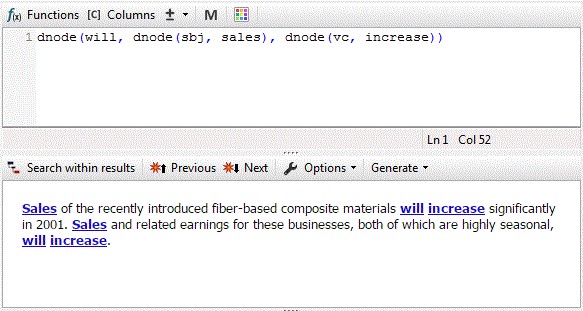dnode
Purpose
The function allows to extract arguments connected by specific dependencies in a dependency graph. This function is useful for extracting “sparse” patterns, i.e. when target words may be separated by many other words.
Arguments
The function takes terms as arguments, as well as special label parameters, the list of which is presented below.
Label |
Meaning |
Example |
ADV |
General adverbial |
also depends \(\text{depends} \overset{adv}{\rightarrow} \text{also}\) |
AMOD |
Adjective or adverbial modifier |
But Edwards was highly critical of Clinton. \(\text{critical} \overset{amod}{\rightarrow} \text{of}\) |
APPO |
Apposition |
David Burnham, one of the authors, says … \(\text{Burnham} \overset{appo}{\rightarrow} \text{one}\) |
BNF |
Benefactor complement (for) in dative shift |
… would continue to provide maintenance services for customers of its … \(\text{provide} \overset{bnf}{\rightarrow} \text{for}\) |
CONJ |
Second conjunct (dependent on conjunction) |
… report purchases and sales … \(\text{sales} \overset{conj}{\rightarrow} \text{and}\) |
COORD |
Coordination |
report purchases and sales \(\text{purchases} \overset{coord}{\rightarrow} \text{and}\) |
DEP |
Unclassified dependency |
But Edwards was highly critical of Clinton. \(\text{was} \overset{dep}{\rightarrow} \text{but}\) |
DIR |
Adverbial of direction |
Now the Alley has moved ahead \(\text{moved} \overset{dir}{\rightarrow} \text{ahead}\) |
DTV |
Dative complement (to) in dative shift |
… of which half may be sold directly to Hewlett-Packard by Octel. \(\text{sold} \overset{dtv}{\rightarrow} \text{to}\) |
EXT |
Adverbial of extent |
Sales rose 4.8% to … \(\text{rose} \overset{ext}{\rightarrow} \text{to}\) |
IM |
Infinitive verb (dependent on infinitive marker to) |
enough money to hire at least one more worker \(\text{to} \overset{im}{\rightarrow} \text{hire}\) |
LGS |
Logical subject of a passive verb |
mitigate problems created by the fact \(\text{created} \overset{lgs}{\rightarrow} \text{by}\) |
LOC |
Locative adverbial or nominal modifier |
They are the best production talent around \(\text{talent} \overset{loc}{\rightarrow} \text{around}\) |
MNR |
Adverbial of manner |
expanded rapidly \(\text{expanded} \overset{mnr}{\rightarrow} \text{rapidly}\) |
NAME |
Name-internal link |
And Bobby Thomson was made a legend. \(\text{Thomson} \overset{name}{\rightarrow} \text{Bobby}\) |
NMOD |
Nominal modifier |
economic news \(\text{news}\overset{nmod}{\rightarrow}\text{economic}\) |
OBJ |
Object |
Company increased sales. \(\text{increased} \overset{obj}{\rightarrow} \text{sales}\) |
OPRD |
Predicative complement of raising/control verb |
… he tried to get Warner to buy … \(\text{tried} \overset{oprd}{\rightarrow} \text{to}\) |
P |
Punctuation |
But Edwards was highly critical of Clinton. \(\text{was} \overset{p}{\rightarrow} \text{.}\) |
PMOD |
Prepositional modifier |
of market \(\text{of}\overset{pmod}{\rightarrow}\text{market}\) |
POSTHON |
Posthonorific modifier of nominal |
Bon-Ton Stores Inc. jumped 10.5 percent. \(\text{Stores}\overset{posthon}{\rightarrow}\text{Inc.}\) |
PRD |
Predicative complement |
Company is a leading manufacturer of… \(\begin{array}{rlc} \text{is} & \overset{prd}{\rightarrow} \text{manufacturer} \\ \overset{sbj}{\downarrow} \\ \text{company} \end{array}\) |
PRN |
Parenthetical |
… are responsible for rising health-care costs, ahead of hospitals (55%) and patients (48%). \(\text{hospitals}\overset{prn}{\rightarrow}\text{%}\) |
PRP |
Adverbial of purpose or reason |
The parks are costly and unique because of that equipment. \(\text{are}\overset{prp}{\rightarrow}\text{because}\) |
PRT |
Particle (part of phrasal verb) |
It will require companies to spell out in more detail… \(\text{spell}\overset{prt}{\rightarrow}\text{out}\) |
ROOT |
Root |
[ROOT] And Bobby Thomson was made a legend. \(\text{[ROOT]}\overset{root}{\rightarrow}\text{was}\) |
SBJ |
Subject |
Sales have increased. \(\begin{array}{rlc} \text{have} & \overset{vc}{\rightarrow} \text{increased} \\ \overset{sbj}{\downarrow} \\ \text{sales} \end{array}\) |
SUB |
Subordinated clause (dependent on subordinating conjunction) |
I am convinced that UFOs exist because … \(\text{that}\overset{sub}{\rightarrow}\text{exist}\) |
TITLE |
Title (dependent on name) |
Dr. Talcott led a team of researchers. \(\text{Talcott}\overset{title}{\rightarrow}\text{Dr.}\) |
TMP |
Temporal adverbial or nominal modifier |
Oil ministers now hope to solve the issue… \(\text{hope}\overset{tmp}{\rightarrow}\text{now}\) |
VC |
Verb chain |
Sales have increased. \(\begin{array}{rlc} \text{have} & \overset{vc}{\rightarrow} \text{increased} \\ \overset{sbj}{\downarrow} \\ \text{sales} \end{array}\) |
The label parameter is optional. If it is not specified, the function matches any argument with any dependency label. It is possible to write more than one dependency label, using the sign "|":
The function can accept more than one token, for example:
In this case the system check, where the argument is a fragment of a tree with one input arrow. If yes, the function considers the links of the tops of the given tree fragment with the other arguments of the function:
will check, if the arrow with the sbj link is in the top of the group phrase(lemma(noun),lemma(adjective)).
If the argument of several tokens is not a fragment of the tree, the function produces a null result.
Nested functions are also used. Nested dnode() functions allow specifying arguments that should depend on the current argument in the dependency graph. Using nested dnode() functions it is possible to match an arbitrary pattern in a dependency graph.
